| Home | Nature Weekly Index |
19 April 2015 | Plectranthus monostachyus (Monkey's Potato) |
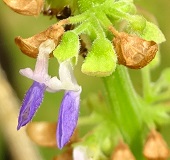
 As the exterior painting work of the apartment block was ongoing over the last few weeks that including my block, many of my potted plants
that were unable to withstand the paint chemicals in the air were wiped out. The most painful part was to watch a flowering
Solanum americanum (Black Nightshade), a rare plant slowly withered and died.
A newly sprouted one was also not spared. Hopefully, there are still some seeds from the last season buried in the soil. One
herbaceous plant that withstand the whole saga very well was the
Plectranthus monostachyus (Monkey's Potato). There were a total of 5 of
them in 2 of the pots, which sprang up spontaneously from seeds hidden in the soil. One was flowering while 3 of them had just came
out of the soil.
As the exterior painting work of the apartment block was ongoing over the last few weeks that including my block, many of my potted plants
that were unable to withstand the paint chemicals in the air were wiped out. The most painful part was to watch a flowering
Solanum americanum (Black Nightshade), a rare plant slowly withered and died.
A newly sprouted one was also not spared. Hopefully, there are still some seeds from the last season buried in the soil. One
herbaceous plant that withstand the whole saga very well was the
Plectranthus monostachyus (Monkey's Potato). There were a total of 5 of
them in 2 of the pots, which sprang up spontaneously from seeds hidden in the soil. One was flowering while 3 of them had just came
out of the soil.
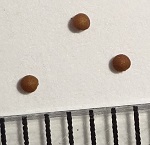
Since I had a flowering Monkey's Potato with matured seed cases, I decided to try to get some pictures of the tiny seeds. The flowers appeared in group along a long stalk and arranged themselves in a radiated manner in 2 opposite bundles. After the flowers dropped off, the remaining structures developed into boat-shaped seed cases. Each seed case housed around 2 round tiny light-brown seeds of about 1 millimetre in diameter.
To look up for more information of this plant, you will need to search for its synonym Solenostemon monostachyus as this name seemed to be used more often than the accepted name Plectranthus monostachyus. I had adopted the common name Monkey's Potato from the Virtual Botanic Garden website. There was no information on how this plant was related to a monkey or a potato though I suspected that it might be referring to the plant's root system.
On 24 February, I prepared a rectangular pot with the intention to grow some Clitoria ternatea (Butterfly Pea) since the existing colony was old and dying. Up till today, there was no sign of the Butterfly Pea seeds buried in the soil. Instead, other baby plants took over the mini plot of land; they were 10 Amaranthus blitum (Livid Amaranth), 3 Monkey's Potato, one Black Nightshade, one red version of Sessile Joyweed (Alternanthera sessilis), one Phyllanthus urinaria (Stone Breaker) and one Eleutheranthera ruderalis (Ogiera). All of them were either the current or past residents of my balcony plant community. Today, only the Monkey's Potato plants were thriving well.
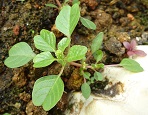

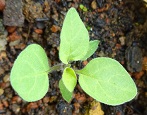

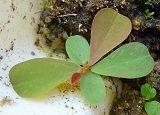

On a separate note, if you are interested to look at the kind of cockroaches that we have around us, not just the common American Cockroach (Periplaneta americana), you can check out my collection of cockroach pictures in my Minibeast section of the website that I had just uploaded yesterday evening.